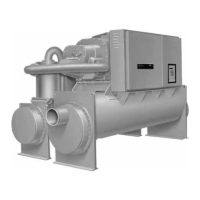Installation, Operation and Maintenance 9 - 1
0DLQWHQDQFH3URFHGXUHV
Cleaning the Condenser
CAUTION
CAUTION: Do not use untreated or
improperly treated water, or equip-
ment damage may occur.
Condenser tube fouling is indicated when the
“approach” temperature (i.e., the difference between
the refrigerant condensing temperature and the
leaving condenser water temperature) is higher than
predicted.
Standard water applications will operate with less
than a 10
°
F approach. If the approach exceeds 10
°
F
cleaning the condenser tubes is recommended.
NOTE: Glycol in the water system typically doubles
the standard approach.
If the annual condenser tube inspection indicates
that the tubes are fouled, 2 cleaning methods can be
used to rid the tubes of contaminants.The methods
are:
q Mechanical tube cleaning- this method is used to
remove sludge and loose material from smooth-
bore condenser tubes.
Mechanical Cleaning Procedure
1 Remove the retaining bolts from the water boxes
at each end of the condenser. Use a hoist to lift
the water boxes.
2 Work a round nylon- or brass- bristled brush
(attached to a rod) in and out of each of the
condenser water tubes to loosen the sludge.
3 Thoroughly flush the condenser water tubes with
clean water.
(To clean internally-enhanced tubes, use a bi-
directional brush or consult a qualified service
organization for recommendations.)
q Chemical tube cleaning
Chemical Cleaning Procedure
q Scale deposits are best removed by chemical
means. Consult a qualified (i.e., one that knows
the local water supply chemical/mineral content)
local chemical supplier for a recommended
cleaning solution suitable for the job. (A standard
condenser water circuit is composed solely of
copper, cast iron and steel.) Improper chemical
cleaning can damage tube walls.
All of the materials used in the external circulation
system, the quantity of the solution, the duration of
the cleaning period, and any required safety
precautions should be approved by the company
furnishing the materials or performing the cleaning.
NOTE: Chemical tube cleaning must always be
followed by mechanical tube cleaning.
Cleaning the Evaporator
Since the evaporator is typically part of a closed
circuit, it does not accumulate appreciable amounts
of scale or sludge. However, if cleaning is deemed
necessary, use the same cleaning methods
described for the condenser tubes.
Compressor Oil
CAUTION
CAUTION: To prevent oil sump heater
burnout, open the unit main power
disconnect switch before removing
oil from the compressor.
Trane polyolester oil is the approved oil for the RTHC
units. Polyolester oil is extremely hygroscopic
meaning it readily attracts moisture. The oil can not
be stored in plastic containers due to the hygroscopic
properties. As with mineral oil, if water is in the
system it will react with the oil to form acids. Use
Table 28
to determine the acceptability of the oil. The
proper charge amounts are given in
Table 29
.
Note: Mineral oil used in the RTHA and RTHB units had different
acceptable levels (< 50 ppm of moisture and < 0.05 mg KOH/g)
Note: Use an oil transfer pump to change the oil
regardless of chiller pressure.
Table 28
POE Oil Properties
Description Acceptable Levels
Moisture content less than 300 ppm
Acid Level less than 0.5 TAN (mg KOH/g)

